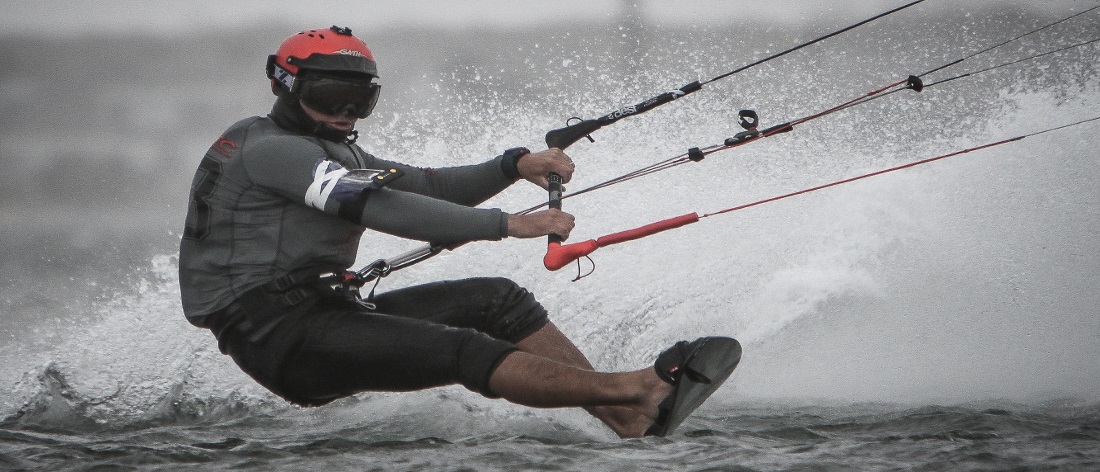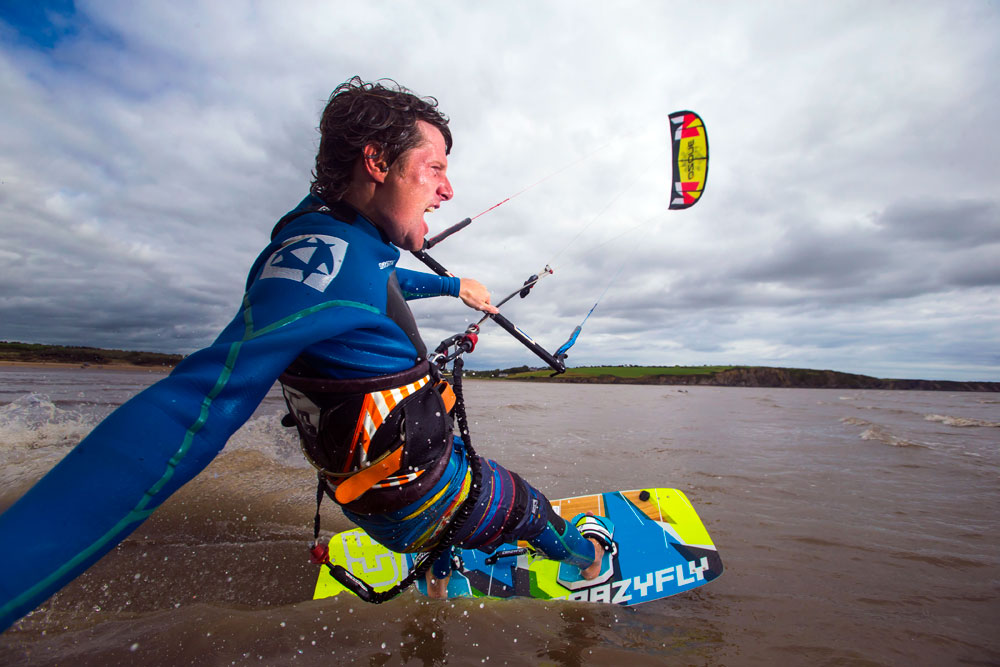How hard is it to learn kitesurfing? Kitesurfing schools often make learning the sport sound easy. Some claim it only takes a few days, while others suggest it can be quite challenging. As a prospective kitesurfer, you need to know what to expect.
While it is possible to learn the basics within a few days to a couple of weeks, the learning curve is steep. You need to master two distinct but interacting skill sets: kite flying and board riding. Both require strong coordination and balance. Although you can learn these skills relatively quickly, it demands intense effort and endurance.

Before diving into the difficulty of learning each kitesurfing skill, let’s briefly discuss some conditions that can make the learning process more challenging.
First is the wind. Contrary to what you might think, rough winds are not the worst for learning; very light winds, under 12 knots, are actually more challenging. Flying a kitesurf kite in light winds is very technical, even with a larger kite, and you’ll frequently drop your kite due to beginner mistakes.
Second is the water. This comes into play during the second part of your learning process—initially, you’ll be acquiring piloting skills on the beach. Waves, chop, and currents can all hinder your learning. From personal experience, rough water conditions made it quite difficult for me to master the water start step.
Third is the equipment. Using a kite that’s too small for the wind speed will cause it to crash frequently, similar to the low wind issue. On the other hand, a kite that’s too large will overpower you, which can be dangerous. You need the right kite size for the conditions, and a good instructor should help you with that.
Additionally, a bow kite is easier to learn on than a C kite. When it comes to the control bar, opt for one with a reliable safety release system that doesn’t activate unexpectedly, a common issue with older equipment that can disrupt your learning.
Lastly, the instructor is crucial. Taking lessons is essential for learning kitesurfing, but make sure to choose an instructor who can communicate effectively (preferably in a language you understand); otherwise, your learning process will be much harder.
With that covered, let’s delve into the difficulty of mastering the main kitesurfing skills.
How difficult is it to read the wind?
This depends on how your brain processes information. Some learners struggle to visualize the “wind window,” a 3D concept showing the wind power relative to your kite’s position in the sky.
Despite being a clear way to understand kite movement, applying this concept in practice is challenging. While the theory is easy to grasp, executing it is more difficult.
When trying to control a speeding kite about to crash, you often forget about the theoretical “window” and zones, going into survival mode and instinctively reacting, usually leading to a crash or unwanted body drag.
Understanding wind theory is straightforward, but applying it in practice takes time and practice to develop the necessary reflexes and muscle memory.

How to Learn to pilot a kitesurf kite?
This ties into the previous section, as grasping the concept of the 3D wind power abstraction is essential.
Learning to fly the kite, starting with a trainer kite and progressing to a kitesurf kite, is initially intuitive: tilting the control bar left steers the kite left, and tilting it right steers it right. You quickly learn to make “8” shapes in the sky and start feeling some traction as the kite moves from one side of the wind window to the other.
The challenge comes with mastering the forward and backward pull on the control bar. Besides steering left or right, pulling the bar down or pushing it out controls the tension in the back lines, which affects the kite’s power.
Many beginners panic when overpowered and instinctively pull the bar more, which increases the kite’s power. This counterintuitive reaction is one of the hardest aspects of kite flying to overcome. Some schools even have T-shirts that say, “Let go of the bar!”
Is it difficult learn power dragging ?
Learning to power drag in the sand (aka “sand skiing”) is not so hard once you’ve learned to control the amount of pull on your back lines, that is, to keep the control bar midway between its lowest and highest positions as you tilt it left and right.
The difficult part when practicing body drag is going in a relatively straight line. When you steer your kite from one half window to the other to generate power and traction on your harness, you tend to get dragged to each side as well. Timing is key to avoiding the kite going too far down before the next turn – that’s a bit tricky to master.
Learning to body drag in the water is easier at first since you just throw the kite into the power zone and let it sweep you downwind. Body dragging upwind, however, requires more subtle, one-hand steering, and maintaining a “fin” position in the water with your free arm. This is another slightly more challenging step to learn in kitesurf.

How difficult is it to start in the water?
Once you get accustomed to powering up your kite and being dragged, the next step is to use that traction to get up and ride on your board. This is one of the most challenging steps, as you need to focus on both your kite and your board at the same time.
Initially, both feet are secured in the board straps, and you try to maintain a crouched, floating position while moving your kite into the power zone.
As the kite pulls you upward and forward, you need to push hard with your legs to stand up while preventing yourself from being thrown forward.
This process requires a lot of balance and coordination. Most people need a few hours and some inevitable faceplants to master this skill.
Is it difficult to ride downwind ?
Once you’ve mastered the water start, riding downwind becomes relatively easier. Now that you know how to get up and moving on your board, the goal is to maintain that momentum.
The main challenge is keeping tension in your lines. Many beginners tend to ride in the same direction as the wind, heading towards the kite, which causes the lines to slacken as the board gains speed, eventually leading to the kite dropping.
While you may initially feel the thrill of riding pulled by the kite, it often doesn’t last long as you lose power and speed. When this happens, you have no choice but to sit back in the water and relaunch your kite if it has fallen.
Is it difficult to ride upwind?
Once you’ve mastered riding downwind, the final step in the learning curve is to learn how to ride upwind. Most people pick up this skill on their own, as it often requires many hours of practice, which can be done without an instructor.
Learning to kitesurf upwind isn’t particularly difficult, but it does take time. Initially, each attempt will likely result in drifting downwind rather than riding upwind, necessitating a walk back up the beach with your kite in the air. This process isn’t hard, but it does consume a lot of time and energy.
During each attempt, the actual time spent practicing upwind riding is limited by the need to walk back up the beach. However, with persistence, everything will eventually click, and you’ll successfully create the necessary opposition between your kite and board directions.
How hard is kitesurfing compared to other board sports ?
While some board sports skills translate to kitesurfing, not all of them do. Many windsurfers find that their windsurfing habits interfere with their kitesurfing learning process.
For example, windsurfers constantly pull on the wishbone to gain speed, but in kitesurfing, pulling the bar doesn’t always create more power—it can sometimes have the opposite effect, depending on the kite’s position in the wind window.
Snowboarding experience can be beneficial for kitesurfing, as you’ll already be familiar with sliding on a strapped board and digging in your board’s rail, which is essential for riding upwind.
Wakeboarding experience can also help shorten the kitesurfing learning curve. However, advanced wakeboarders may struggle with the difference in pull direction. In wakeboarding, the pull from the boat is horizontal, while in kitesurfing, the pull is more vertical.
This difference results in varying stances and body positions, making kitesurfing more challenging for experienced wakeboarders, not to mention the need to learn the specific kite flying skills.

